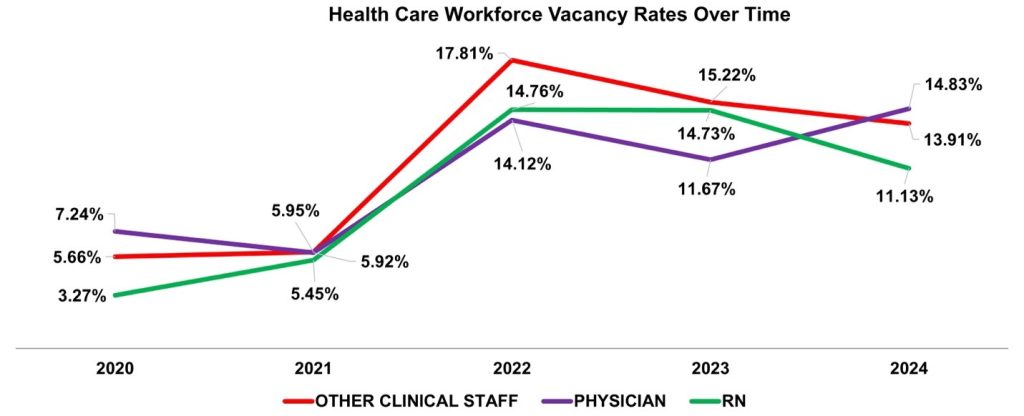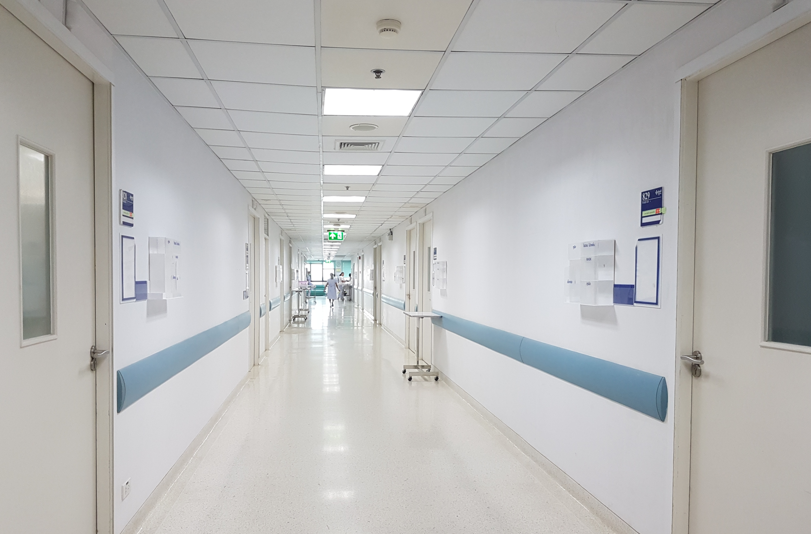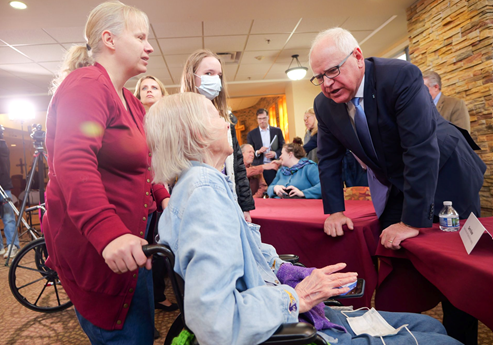Nursing vacancies fell, although the full-time nursing workforce has declined to its lowest share ever and physician ranks are dwindling across Minnesota.
September 3, 2024, Saint Paul, Minn. – A new Minnesota Hospital Association (MHA) analysis of health care workforce data shows hospitals and health systems are finally replenishing their staff in the wake of the COVID-19 pandemic.
The data comes from a months-long survey of human resources at most Minnesota hospitals, health systems, clinics, and other facility settings. It shows job vacancies among nurses, a key employment indicator, declined notably in 2023 for the first time since the pandemic. Separations and vacancies among nursing staff had grown rapidly as the state grappled with COVID-19 starting in 2020.

Overall, the number of working nurses also grew for the fifth straight year – although barely two in five registered nurses are choosing to work full time and the proportion of nurses working full time (defined as over 32 hours a week) has hit all-time low.
“Hospitals provide good, well-paying careers, and data shows that Minnesotans are responding by filling the ranks of care providers and support staff,” said MHA president and CEO Rahul Koranne. “But we are also seeing that significant headwinds remain for the health care workforce, particularly among physicians and rural providers.”
Data shows more than one in seven general practice doctors in Minnesota will reach retirement age in the next five years. For specialty physicians, the number is nearly one in five. A new national survey just found that more than 60% of doctors are considering retirement, finding a new job or changing careers, citing growing workloads.
Greater Minnesota also continues to experience heightened workforce challenges. Physician employment grew in the Twin Cities but fell in Greater Minnesota. Also, providers outside the Twin Cities saw a 22% increase in nurse departures last year, compared to 2023.
Other findings in the data, which includes both MHA and government statistics include:
- Average pay for registered nurses (RNs) in Minnesota hit nearly $95,000 in 2023, up by 6.7% from 2022, according to federal data. That was the biggest increase in more than a decade.
- From 2022 to 2023, RN licensees grew 9.3% and have increased by 17.6% over the past five years.
- Workforce diversity continues to improve, up by a full percentage point, to 13.4%, among nurses. The proportion is approaching 15% overall for hospital workforces.
- Licensed Practical Nurses (LPNs) and Certified Nursing Assistants (CNAs) continue to upgrade within the health care field with an average of 3.8% of LPNs and 4.6% of CNAs getting their RN license annually over the last three years.
Workforce issues are of critical importance to health care in Minnesota. Declining birth rates, aging population, rising retirements, and falling net migration have had historic impacts on the state’s workforce. According to the Minnesota Business Partnership, labor participation fell by 7% between 2001 and 2022, a reduction of 325,000 workers in the state – almost the equivalent of the entire direct care health care workforce in 2023.
This year’s MHA Workforce Report has some bright spots and shows that strategies like flexible schedules and pay increases can help declines in the workforce. Healthjob.org reported in August that Minnesota nurses had the highest pay of any state in the U.S., adjusted for the cost of living. Both Minneapolis and St. Paul made it separately into the Healthjob.org top 10 ranking of U.S. cities.
But our state needs more efforts to ensure that Minnesotans have long term access to the care they need, when and where they need it. Innovative efforts that are in progress to shore up the health care workforce include:
- Medical school campuses in development in St. Cloud and Duluth.
- The new nursing program at the University of St. Thomas.
- Work to increase interest in health care careers through internship programs, such as those sponsored by the Minnesota Hospital Foundation.
More state support is also needed to build the healthcare workforce, including:
- Health professional loan forgiveness
- Joining the Nurses Licensure Compact
More data is available in this presentation online. You can also see and hear more about this data in a video summary from MHA Data Analyst Molly Yang, also available on the MHA Facebook page. For interviews or further information, contact Lou Ann Olson or Tim Nelson at the Minnesota Hospital Association.


